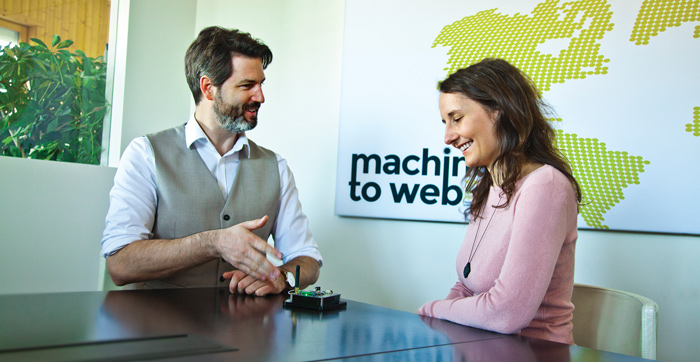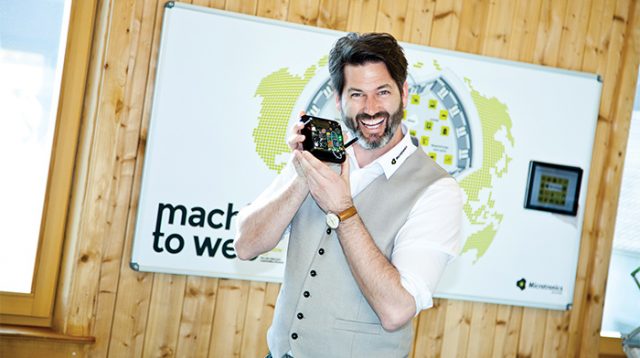Stefan Pfeffer is the chief financial officer and a founder of Microtronics Engineering, the provider of complete IoT solutions consisting of hardware, software and services. Microtronics develops and operates customised Internet of Things (IoT) applications based on its rapidM2M technology, which enables easy development and convenient management of IoT projects throughout their entire lifecycle.
With more than ten years of experience in IoT, Pfeffer has a deep understanding of how to create value from IoT projects. As a finance professional, business performance is always important to him and his focus is on how customers benefit and the value that is created from IoT deployments. Here, he tells George Malim how customers can focus their strategies to ensure their IoT deployments enable new businesses that earn money and enable new revenue streams to be opened up.
George Malim: Are the strategic and management challenges of IoT starting to outweigh the technical issues organisations face as they start to scale up their IoT activities?
Stefan Pfeffer: Microtronics has been in this field for more than 12 years so we have a lot of experience bringing real, live IoT projects to the market. Based on that, we’ve been using IoT technologies for many years and technology is not the issue anymore. The issue is how to manage the changes in your company that are connected to implementation of IoT technologies.
You can use technology off the shelf but when you do that, you have to ensure your organisation and procedures can manage the change the technology will bring. You might need new employees, skills, processes and strategies. These elements are very important for success and it’s vital to make sure you’ve prepared these in advance of IoT deployment. Success is dependent on the culture of the entire company.
GM: What, beyond technology specification, do you see as the greatest challenges facing organisations as they roll-out IoT services to their customers?
SP: It’s the non-technical transformation. For example, traditionally you have very clear sales structures within a company and you typically sell through different channels so, as a manufacturer, you’re not familiar with your end customers. This is handled by a dealer or distributor network.
With IoT, though, you get direct access to your end customer and for many organisations this could be for the first time. You therefore may not be used to managing customers and serving them directly and this is capability that you will have to think about. Servitization of a product, for example, means you have to consider how you will sell the service, how you will support customers and how you will maintain the equipment.
Some will need to learn these skills and part of that will involve managing wholesale and retail partners. Consider how your deployment will impact relationships with these and your end customers. For instance, will you need a support line to handle the new requirements?
These considerations are challenging and there is a big risk to organisations in moving to having direct contact with customers. This is offset by the value in the direct information organisations will gain which is typically a very good thing for their businesses.
GM: How does Microtronics’ rapidM2M technology help organisations manage IoT projects from early start-up through to maturity and beyond?
SP: rapidM2M is the perfect combination between already solved challenges and the necessary flexibility to realize your own IoT project. You can totally focus on your application and benefit from the fully developed technology.
For example, there are mature over the air update mechanisms which is important when you have a thousand or more devices in the field. Furthermore, the rapidM2M runtime environment makes sure, that you cannot break down the device with your own script. The predefined data structure supports you with error messages, for example, according the connectivity.
There are three types of fully managed connectivity which handle synchronisation with the cloud. You do not have to send the data immediately and can store it temporally on the device.
All those features are easily implemented with libraries. That’s how you can focus completely on your application and let rapidM2M do the dirty work.

GM: Does the end goal have to be identified before the project begins?
SP: It’s important to have a clear vision of what your expectations are before you start in order to avoid drifting in an unfocused way and starting projects that never end. Think big, start small and smart is the motto. Have the scalability in mind, but start with the minimum viable product (MVP) and gain first quick wins.
Microtronics is able to help with this because we have a lot of experience – we’ve completed approximately 300 projects across industries in over 60 countries in the past and this has given us a lot of knowledge. We know how to support our customers and how to bring their deployments to fruition in a defined timeframe.
GM: To what extent is it possible to have a system that encompasses requirements that have been proven to be necessary for success as well as one that provides the flexibility to fit the myriad requirements of different IoT use cases and business models?
SP: On one side, the issue is still technical and our experience helps customers progress. However, operational issues are increasingly hampering organisations deployments. We take on lots of projects in the field which are ongoing. Customers get stick at a point where they can’t go any further and we can bring in a prospective strategy to get them past this point. Ultimately, a successful IT solution works with a strong business case behind it. Finding that whether it’s about substantial cost savings or an exciting new business opportunity usually stimulates progress.
Therefore, it is important that the customer can focus on his core business. He is the expert in the application. He does not need to be technical expert too. That’s why we solve all the deep technical issues for our customers and offer defined interfaces which enables them to easily build their solution on a strong fundament.
GM: Microtronics’ offering brings together hardware, software and services. How important is it that all of these are encapsulated in a holistic IoT solution?
SP: Have you ever tried to share a document with different users via various end devices, operating systems and software tools? It sounds so easy, but can result in ugly designs and many more problems. That’s the same with data. A lot of converting work has to be done. For example, you have to convert data from hex to decimal or take care of different time formats. You have to push bits around and make sure that in the end each part from the field to the visualisation on the server works smoothly together.
When it comes to considering scalability this situation gets even more complex. An integrated device and lifecycle management out of the box is needed to understand what happened to the devices. I need to know the different hardware, firmware and software versions, have defined update mechanisms to guarantee functionality. That are just a few advantages from a holistic approach.
GM: Please can you share some examples of how customers are using rapidM2M to achieve their IoT goals?
SP: Our customers have different goals and they range from start-ups to SMEs and corporates. All use the same foundational technologies so it doesn’t matter how big a company is, you can bring the idea to market from a technical point of view. Thinking big and starting smart is the quick way to a successful IoT project.
We are working, for example, with a start-up offering parking management in cities for short-time renting of existing, private parking garages. We also work with SMEs which have embedded our IoT solution in their products in order to connect them and get data for maintenance but also to build new services for their customers. The opportunities go up to a massive steel company managing its production facilities. Domestic robotics, artificial intelligence and a raft of consumeroriented products will lead to even more opportunities in the IoT sector. I am sure there are potential IoT customers in every business.
GM: 2019 looks to be a tipping point in which IoT moves on from trials and pilots and into the mass market. What indicators of this are you seeing?
SP: While we have been in this field for more than 12 years, in the last three to five years we have seen a lot more companies working intensively on their IoT deployments. The indications are that, from a business perspective, companies already have the budgets for digitalisation and IoT so it’s now a case of recognising the importance of being prepared for making these projects a reality. The technology is available and companies have been playing around for a while now. Their first steps and their initial proof of concepts have given them trust in the solutions. They see the potential and are now ready to play the game seriously.
On top of this, governments are taking an important role in pushing digitalisation and IoT forward. As a consequence, there is very good awareness of IoT and digitalisation.










